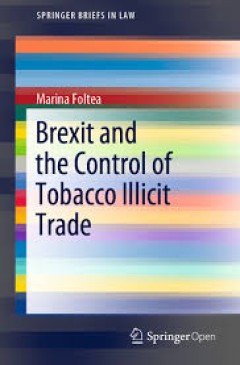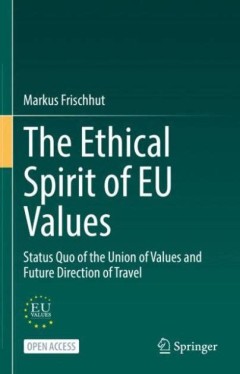Filter by

Collective Actions in Europe : A Comparative, Economic and Transsystemic Anal…
This open access book offers an analytical presentation of how Europe has created its own version of collective actions. In the last three decades, Europe has seen a remarkable proliferation of collective action legislation, making class actions the most successful export product of the American legal scholarship. While its spread has been surrounded by distrust and suspiciousness, today more t…
- Edition
- -
- ISBN/ISSN
- 978-3-030-24222-0
- Collation
- IX, 122
- Series Title
- SpringerBriefs in Law (BRIEFSLAW)
- Call Number
- -

Brexit and the Control of Tobacco Illicit Trade
This book assesses the consequences of Brexit for the control of illicit trade in tobacco products in the UK and EU. Based on the currently applicable legal framework, it examines the significance of a possible non-application of the acquis communautaire in the UK in matters relating to anti-illicit trade in tobacco legislation. It also analyses the modes of future cooperation between the UK a…
- Edition
- -
- ISBN/ISSN
- 978-3-030-45979-6
- Collation
- XI, 81
- Series Title
- SpringerBriefs in Law (BRIEFSLAW)
- Call Number
- -

Implementation of EU Readmission Agreements : Identity Determination Dilemmas…
By examining the implementation dynamics of EU Readmission Agreements (EURAs), this book addresses the practical reasons why irregular immigrants cannot be expelled. EURAs are one of the vital legal instruments framing EU external migration law with regard to the expulsion of irregular immigrants, yet their implementation has met with various obstacles. Above all, the process of determining an …
- Edition
- -
- ISBN/ISSN
- 978-3-319-42505-4
- Collation
- XVII, 83
- Series Title
- SpringerBriefs in Law (BRIEFSLAW)
- Call Number
- -

Ethics and Civil Drones : European Policies and Proposals for the Industry
This open access book disseminates some of the results of the European H2020 AiRT Project (Technology transfer of RPAs for the creative industry). In particular, it presents findings related to mitigating safety and security concerns when civil drones are piloted by the service sector (mainly, the creative industry). European policies regarding drones generally focus on outdoor drones, but they…
- Edition
- -
- ISBN/ISSN
- 978-3-319-71087-7
- Collation
- X, 92
- Series Title
- SpringerBriefs in Law (BRIEFSLAW)
- Call Number
- -

Selbstbestimmung, Privatheit und Datenschutz : Gestaltungsoptionen für einen…
In diesem Open-Access-Sammelband werden die aktuelle Herausforderungen für Privatheit und Datenschutz aufgezeigt, die durch die zunehmende Digitalisierung entstehen. Die Beitragsautoren analysieren, wie diese durch Governancemechanismen adressiert werden können. Als Alternative zu einem rein profitorientierten Digitalkapitalismus bzw. Digitalautoritarismus wird für einen eigenständigen euro…
- Edition
- -
- ISBN/ISSN
- 978-3-658-33306-5
- Collation
- XXIX, 508
- Series Title
- DuD-Fachbeiträge (DUDGABLER)
- Call Number
- -

Guide to Qualitative Research in Parliaments: Experiences and Practices
This open access book is a hands-on guide on doing qualitative research in parliaments, exploring achievements and drawbacks for all. From early-career scholars looking for an ‘in’ to start their research to senior academics interested in methodological details, the book offers a novel approach to discussing qualitative methodologies. It presents unique insights based on a large-scale quali…
- Edition
- -
- ISBN/ISSN
- 9783031398087
- Collation
- XVII, 149
- Series Title
- -
- Call Number
- -

Security in an Interconnected World : A Strategic Vision for Defence Policy
This open access book follows the idea that security policy must be based on strategic analysis. Defence policy and the role of the armed forces can subsequently be determined on the grounds of said analysis. More than ever, internal and external security, and developments both in the Netherlands and abroad are interconnected. The world order is shifting, the cooperation within NATO and the EU …
- Edition
- 1
- ISBN/ISSN
- 9783030376062
- Collation
- X, 183 hlm,: ill, lamp;
- Series Title
- -
- Call Number
- -

European Variations as a Key to Cooperation
This Open Access book offers a novel view on the benefits of a lasting variation between the member states in the EU. In order to bring together thirty very different European states and their citizens, the EU will have to offer more scope for variation. Unlike the existing differentiation by means of opt-outs and deviations, variation is not a concession intended to resolve impasses in negotia…
- Edition
- 1
- ISBN/ISSN
- 9783030328931
- Collation
- XX, 177 hlm,: ill, lamp;
- Series Title
- -
- Call Number
- -

The Future of Radioactive Waste Governance : Lessons from Europe
This Open Access book examines the radioactive waste management policies of ten European countries: Belgium, Finland, France, Germany, Italy, the Netherlands, Spain, Sweden, Switzerland and the United Kingdom. Most countries are in the process of planning and creating final storage solutions, while none has yet finalized this process. Over the past decades many countries have been renewing thei…
- Edition
- -
- ISBN/ISSN
- 978-3-658-40496-3
- Collation
- XVII, 345
- Series Title
- Energiepolitik und Klimaschutz. Energy Policy and Climate Protection (EPKS)
- Call Number
- -

The Ethical Spirit of EU Law
This open access book seeks to identify the ethical spirit of European Union (EU) law, a context in which we can observe a trend towards increasing references to the terms ‘ethics’ and ‘morality’. This aspect is all the more important because EU law is now affecting more and more areas of national law, including such sensitive ones as the patentability of human life. Especially when une…
- Edition
- 1
- ISBN/ISSN
- 9783030105822
- Collation
- XIX, 157 hlm,: ill, lamp;
- Series Title
- -
- Call Number
- -
 Computer Science, Information & General Works
Computer Science, Information & General Works  Philosophy & Psychology
Philosophy & Psychology  Religion
Religion  Social Sciences
Social Sciences  Language
Language  Pure Science
Pure Science  Applied Sciences
Applied Sciences  Art & Recreation
Art & Recreation  Literature
Literature  History & Geography
History & Geography